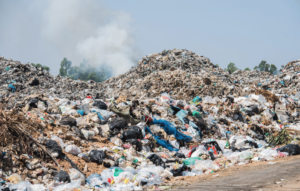Today, we are increasingly becoming aware of the many environmental challenges we face – this has led to the conversation around menstrual hygiene taking on some new dimensions. Menstrual health isn’t just a personal issue as it is often thought to be; it’s a critical environmental concern that demands our attention. Traditional disposable menstrual products, such as sanitary pads and tampons, contribute significantly to pollution and waste. This makes the shift towards sustainable menstrual health products not only beneficial but essential as we strive for responsible stewardship of our planet.
In this blog, we’ll explore the often-missed connection between menstrual health and environmental sustainability. We will look into the environmental impacts of disposable menstrual products, the benefits and challenges of sustainable alternatives, and why this shift is crucial for our planet’s future. Whether you’re new to the concept of sustainable menstrual health or looking to deepen your understanding, this guide will provide you with the insights and knowledge you need to make informed, eco-friendly choices.
The Environmental Impact of Disposable Menstrual Products
The environmental footprint of disposable menstrual products is staggering. Each year, billions of sanitary pads and tampons are discarded, often ending up in landfills or, worse, our oceans and waterways. These products are primarily made from non-biodegradable materials, such as plastic, which can take hundreds of years to decompose. The result is a growing mountain of waste that contributes to pollution, harms wildlife, and disrupts ecosystems.

Moreover, the production of disposable menstrual products is resource-intensive. The manufacturing process requires significant amounts of water, energy, and raw materials, further exacerbating the environmental toll. The chemicals used in these products can also leach into the soil and water – not to mention people – posing additional health risks to humans and animals alike.
In many low- and middle-income countries, the challenge of menstrual waste management is even more pronounced. Limited access to proper disposal facilities often leads to unsafe practices like burning or burying used products, which can degrade air and soil quality. These practices not only harm the environment but also pose health risks to communities and waste management workers.
Given these significant environmental impacts, the shift towards sustainable menstrual health products is not just a preference but a necessity. Sustainable alternatives like menstrual cups, reusable cloth pads, and biodegradable products offer a promising solution to reduce the environmental burden and promote healthier, more sustainable menstruation practices.
The Benefits and Challenges of Sustainable Menstrual Health Products
Sustainable menstrual health products, such as menstrual cups, reusable cloth pads, and biodegradable tampons, present an eco-friendly alternative to traditional disposables. These products are designed to minimize waste, reduce resource consumption, and offer long-term cost savings. Here are some key benefits:
Environmental Benefits
- Reduced Waste: Reusable menstrual products significantly decrease the amount of waste generated. For example, a single menstrual cup can last up to ten years, eliminating the need for thousands of disposable products over its lifetime.
- Lower Carbon Footprint: The production and disposal of sustainable menstrual products require fewer resources, resulting in a smaller carbon footprint. Biodegradable options also break down more quickly and safely in the environment.
- Decreased Pollution: Using products made from natural or biodegradable materials helps reduce the release of harmful chemicals into the environment.

Health Benefits
- Reduced Exposure to Chemicals: Many traditional menstrual products contain unregulated chemicals and synthetic materials that can cause irritation or health issues. Sustainable products are often made from natural, hypoallergenic materials, offering a safer option for sensitive skin.
- Improved Comfort and Health: Users of menstrual cups and cloth pads often report greater comfort and fewer instances of irritation or infections compared to those using disposable products.
However, despite these advantages, the adoption of sustainable menstrual health products faces several challenges:
Societal Stigma and Taboo
- Menstrual health stigmas remain a significant barrier, particularly in cultures where discussing menstruation is taboo. This can make it difficult to promote and normalize the use of reusable products.
Access and Affordability
- In many low- and middle-income countries, access to sustainable menstrual products is limited. The initial cost of items like menstrual cups can be a barrier, even though they may be cost-effective in the long run.
- Ensuring access to clean water and proper sanitation facilities is crucial for the safe use of reusable products, which can be a challenge in some regions.
Education and Awareness
- A lack of knowledge about the benefits and proper use of sustainable menstrual products hinders their widespread adoption. Comprehensive education and outreach efforts are needed to inform and empower individuals to make the switch.
Addressing these challenges requires a multifaceted approach that includes education, policy changes, and community engagement. By overcoming these barriers, we can pave the way for broader acceptance and use of sustainable menstrual health products, benefiting both individuals and the environment.
Climate Change and Menstrual Sustainability
Climate change poses a significant threat to the sustainability of menstrual health practices. As extreme weather events such as droughts, floods, and hurricanes become more frequent and severe, the challenges associated with managing menstruation intensify. These environmental disruptions impact access to essential resources and services, complicating efforts to maintain menstrual hygiene and health.
Access to Water and Sanitation
- Scarcity of Resources: Climate-induced events can lead to water shortages, making it difficult for individuals to maintain proper hygiene during menstruation. Reusable products, which require regular cleaning, can become less viable in areas where water is scarce.
- Damaged Infrastructure: Floods and other disasters can destroy sanitation facilities, limiting access to safe and private spaces for managing menstruation. This not only affects personal hygiene but also dignity and comfort.
Disruption of Supply Chains
- Product Availability: Extreme weather events can disrupt supply chains, making it challenging to distribute both disposable and sustainable menstrual products. This is especially critical in remote or underserved communities where access is already limited.
- Economic Impacts: Natural disasters often result in economic hardships, reducing the affordability and accessibility of menstrual products for many individuals.
Increased Vulnerability
- Displaced Populations: People displaced by climate-related events often find themselves in precarious living conditions with inadequate facilities for managing menstruation. This increases their vulnerability to health issues and exacerbates existing inequalities.
- Health Risks: Poor menstrual hygiene management in the wake of climate disasters can lead to infections and other health complications, further burdening already strained healthcare systems.
To address these intertwined challenges, it is crucial to integrate climate resilience into menstrual health initiatives. This involves:
- Promoting Climate-Resilient Menstrual Products:
- Developing and distributing menstrual products that require minimal water for cleaning or are biodegradable, reducing their environmental impact even in disaster scenarios.
- Strengthening Infrastructure and Services:
- Investing in robust water and sanitation infrastructure that can withstand extreme weather events, ensuring continuous access to necessary resources for menstrual hygiene.
- Enhancing Emergency Preparedness and Response:
- Including menstrual health supplies and facilities in emergency preparedness plans and relief efforts, ensuring that affected individuals can manage their menstruation with dignity and safety during crises.
- Raising Awareness and Advocacy:
- Educating communities about the impact of climate change on menstrual health and advocating for policies that support sustainable practices and climate adaptation measures.

By proactively addressing the intersection of climate change and menstrual sustainability, we can ensure that menstrual health practices remain resilient and environmentally responsible, even in the face of growing climate challenges.
Closing Thoughts
As we have explored, menstrual health and hygiene management (MHHM) is intricately linked to environmental sustainability and climate resilience. The traditional use of disposable menstrual products poses significant environmental challenges, from pollution and waste to resource depletion and health risks. However, the shift towards sustainable menstrual products such as menstrual cups, reusable cloth pads, and biodegradable options presents a promising solution to these issues.
Adopting sustainable menstrual health practices offers numerous benefits, including reducing waste, lowering carbon footprints, and improving individual health. Despite the challenges of societal stigma, access, and affordability, it is essential to promote and support these eco-friendly alternatives. Addressing these barriers through education, policy changes, and community engagement can pave the way for broader acceptance and use of sustainable menstrual products. 
Moreover, climate change further complicates menstrual sustainability by impacting access to water, sanitation, and hygiene services, especially during extreme weather events. By integrating climate resilience into menstrual health initiatives and promoting climate-resilient products and infrastructure, we can ensure that menstrual hygiene management remains sustainable and effective even in the face of environmental challenges.
In conclusion, the journey towards sustainable menstrual health is a crucial step in protecting our planet and promoting public health. By understanding the profound connections between menstrual health, environmental sustainability, and climate change, we can empower individuals to make informed, eco-friendly choices. Together, we can foster a more equitable and sustainable future for all.









